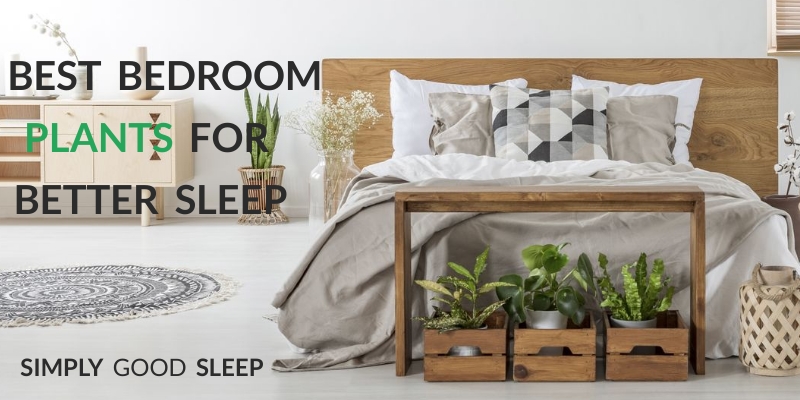
There is a lot of interest in bringing the outdoors indoors lately. It’s not hard to understand why. Not only do plants make a space look better or help promote good feng shui, but they can have other health benefits too.
Having plants in the bedroom can have a calming influence. Decorating your bedroom with plants can help you relax, reduce stress, and help you to sleep at night. Here are the best bedroom plants for better sleep.
1. Lavender for Deep Sleep
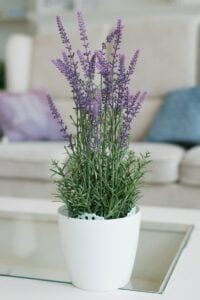 Lavender is the bloom for you if you have a hard time falling asleep at night and if you’re in need of some decorative color in your bedroom. With its gorgeous tall purple blooms, the lavender plant is perfect for the bedroom.
Lavender is the bloom for you if you have a hard time falling asleep at night and if you’re in need of some decorative color in your bedroom. With its gorgeous tall purple blooms, the lavender plant is perfect for the bedroom.
Lavender is known around the world for being good for relaxation. It has been shown to lower stress, blood pressure, and heart rate. Beloved for its sweet, pleasant scent, lavender has also been shown to calm nerves and help people sleep. These benefits are what makes the lavender plant among the best plants for better sleep.
Scented lavender bath oil has been shown to help babies sleep, so imagine what the plant itself can do.
Lavender plants require sunlight and warmth. Place lavender plants on a sunny windowsill. They don’t need too much water though. Water sparingly, and keep the soil well-drained.
Keep them out of reach of your pet dogs and cats as they can be mildly toxic.
2. Valerian For Inducing Sleep
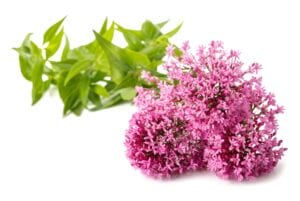
Valerian plants have lovely, little white and pink flowers that make them shine wherever they are. They have been used as a traditional remedy for insomnia and other sleeping problems for centuries.
Inhaling the scent of a valerian has been shown to not only induce sleep but also improve sleep quality. If you can’t get to sleep at night then consider adding some petals to a bath before bedtime.
Keep in mind your valerian plant needs sunlight and so should be kept by the window. It grows well in moist, loamy soil. Water regularly.
3. Gardenia for Uninterrupted Sleep
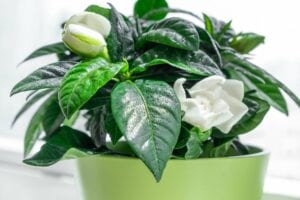 Gardenia, also known as Cape Jasmine, with its creamy white, fragrant blooms contrasting beautifully with their emerald green leaves, has been shown to reduce stress, calm nerves, and promote sleep.
Gardenia, also known as Cape Jasmine, with its creamy white, fragrant blooms contrasting beautifully with their emerald green leaves, has been shown to reduce stress, calm nerves, and promote sleep.
One study found that, with gardenia, you are unlikely to wake up in the middle of the night and more likely to have a good night sleep. Consider picking up some gardenia for your bedroom for better sleep.
Keep gardenias on the bedroom window sill. Gardenias needs direct sunlight through a sunny window. Ensure the soil is moist and well-drained.
4. Areca Palm For Air Purification
This relatively tall, large gorgeous palm makes a lovely houseplant. Areca palm can grow anywhere from 6 to 7 feet, and brings a tropical feel to your bedroom with its exotic-looking, narrow, yellow/greenish, featherly fronds. 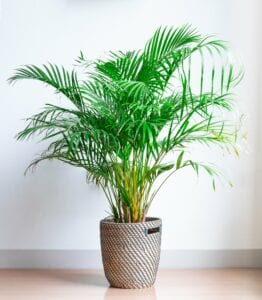
The areca palm became popular as a houseplant due to air purifying research conducted by Dr. Bill Wolverton and NASA. Fifty plants were tested for their ability to filter the air around us, ease of care, and ability to add moisture to the surrounding atmosphere.
The areca plant, in particular, was found to be able to filter out volatile organic compounds (VOCs) from the air. In fact, the areca palm secured first place, scoring highly in all categories tested, making it the best indoor houseplant at purifying and cleaning the air.
Areca palms also work great as natural humidifiers to prevent allergies, asthma, and colds from getting in the way of a good night’s sleep.
This plant requires bright, indirect light – the more direct the light intensity is, the more yellow the leaves will be. They require regular watering in spring and summer so the soil is kept moist, but in winter and autumn you can allow it to dry between watering sessions.
5. Peace Lily for Better Humidity
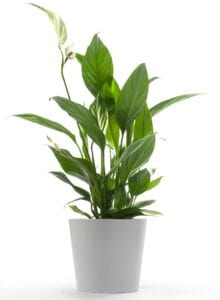
Native to tropical America and southeastern Asia, the peace lily is another natural air purifier. A research from Japan
found that the peace lily was effective in removing toluene and xylene from the air.
Peace lilies can boost humidity levels, which is good for breathing during sleep. Low humidity can cause static electricity, make you more susceptible to respiratory illnesses and colds, and creates an environment where bacteria thrives and spreads.
Peace lilies are beautiful white flowers that don’t require much light or water, making them perfect for a bedroom.
Keep them out of reach of children and pets, as they are mildly toxic.
6. Jasmine for Relaxation

Consider growing jasmine as a houseplant in your bedroom. Jasmine plants are known for their delicate, pretty, white, fragrant flowers that you can smell from feet away. They have a very sweet smell to them that is found in jasmine essential oils for relaxation.
Studies have shown the scent helps to reduce anxiety and improve overall sleep quality. In one study, twenty people slept — with no scent, lavender scent, or jasmine scent. People in the jasmine group experienced better quality of sleep.
Jasmine is easy to keep in a pot and it looks good in a bedroom. Keep yours near the window and give it plenty of water when it’s flowering. During the off-season let the top of the soil dry out a little to prevent over-watering.
7. Snake Plants for Air Purification
The snake plant, also known as Sansevieria trifasciata or mother-in-law’s tongue, is a popular and hardy plant that hails from tropical and sub-tropical Africa, Asia, and Europe.
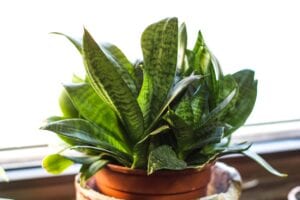 With its sword-shaped, evergreen leaves, the snake plant is nature’s air purifier. These plants give out oxygen at night to help you get better sleep. They also detoxify the air, absorbing harmful chemicals like toluene, trichloroethylene, and formaldehyde. Formaldehyde, in particular, generally found in hair products can cause breathing problems so it’s good to have some snake plants around to keep the air clean.
With its sword-shaped, evergreen leaves, the snake plant is nature’s air purifier. These plants give out oxygen at night to help you get better sleep. They also detoxify the air, absorbing harmful chemicals like toluene, trichloroethylene, and formaldehyde. Formaldehyde, in particular, generally found in hair products can cause breathing problems so it’s good to have some snake plants around to keep the air clean.
A snake plant is easy to care for, making it a perfect choice as a first houseplant. Indirect sunlight is ideal for a snake plant. Because the roots of a snake plant can rot easily, take care to not water a snake plant too much and ensure the soil is well-drained. Allow the soil to dry in between waterings.
If you have pets or young children, keep them away from snake plants. Snake plants can cause nausea, vomiting, diarrhea, and excessive salivation. Avoid such accidents while enjoying your greenery.
8. Golden Pothos for the Ceiling
With its often green — or variegated in yellow, white, or pale green — heart-shaped leaves, the golden pothos plant is one of the top 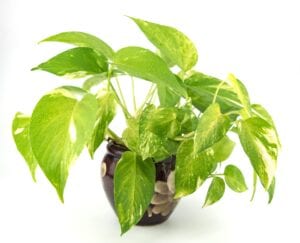 air-purifying plants from the NASA clean air study. Golden pothos eliminate pollution and other particulates — such as formaldehyde — from the air. They keep the air fresh so you have no problems breathing and sleeping at night.
air-purifying plants from the NASA clean air study. Golden pothos eliminate pollution and other particulates — such as formaldehyde — from the air. They keep the air fresh so you have no problems breathing and sleeping at night.
Keep your golden pothos plant in a container hung from the ceiling of a bedroom. Place it in the corner to brighten up your bedroom or place it near windows.
Golden pothos is easy to care for — it requires not much sunlight and demands infrequent watering, about once a week. Water it only when the soil is completely dry to avoid root rot.
The only drawback of this plant is that it’s poisonous if eaten, so you don’t want to keep this plant at home if you have pets or young children.
9. Orchids for Air Quality
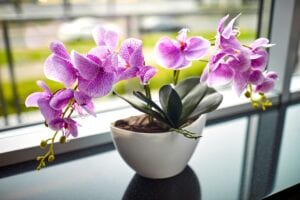
Consider gracing your window sill, dresser, or the bedside table in your bedroom with an orchid. Orchids are popular due to their beautiful, long lasting blooms and elegant form.
In addition to making breathtaking accent pieces, orchids are fantastic bedroom plants for their air purifying qualities.
This tropical flower helps you sleep by producing a lot of oxygen for you. Keep your orchid on your nightstand for easy breathing at night and beautiful blooms to wake up to in the morning.
Your orchid will need a lot of watering but should be allowed to dry out between waterings. Orchid plants also need humidity, about fifty to seventy percent.
10. Aloe Vera for Fresh Air
Most people know about the healing properties of aloe vera. 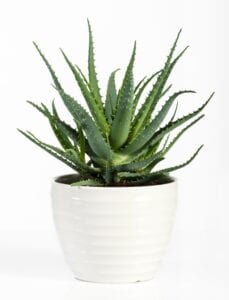
What most people don’t know is that it also works wonders in the bedroom. It’s another plant that continues to release oxygen into the air during the night and helps us breathe easier while we sleep. This plant, in particular, is great for purifying benzene and formaldehyde.
It helps improve the quality of the air whilst you sleep and is also NASA approved. You’ll be able to sleep much sounder with some aloe vera around.
Place the aloe vera in a sunny spot on the window sill. Known as a ‘succulent plant’, aloe vera needs waterings infrequently, about every three weeks. Allow the soil to dry at least 1 to 2 inches deep between waterings to help prevent rot.
Keep aloe vera away from your pet dogs and cats as it can be mildly toxic, as per the Pet Poison Helpline.
11. Chinese Evergreen Plants for Sleep
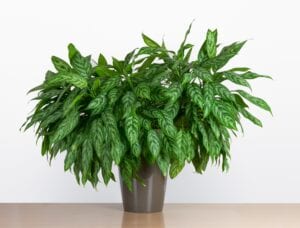 Chinese evergreens have long, pointy dark-green leaves with patterns of white, grey and cream throughout the leaves, which give it a distinctive look, and they usually grow anywhere from 2 to 3 feet.
Chinese evergreens have long, pointy dark-green leaves with patterns of white, grey and cream throughout the leaves, which give it a distinctive look, and they usually grow anywhere from 2 to 3 feet.
They are effective at helping you sleep because they remove toxins and pollutants from the air, making you more comfortable for a good night sleep.
The Chinese evergreen plant is low maintenance and can survive most conditions (no water, no light, low levels of humidity) better than the majority of other house plants, and does a great job of it!
Place Chinese evergreens in indirect sunlight and keep them at temperatures higher than 60 degree F (16 degrees C). Keep the soil well-drained but not drenched to prevent root rot.
12. Bromeliad For Clean Air 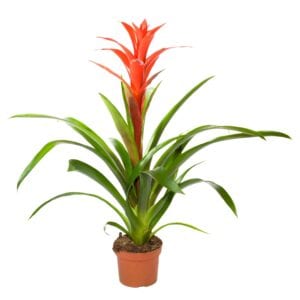
Bromeliads are tropical plants that work similar to orchids in how they keep the air clean. They absorb a lot of carbon dioxide during the day and release a lot of oxygen at night.
Not only do they look amazing, but they also work around the clock to create the ultimate sleep environment. Pair them up with another exotic plant to turn your bedroom into a sleeper’s paradise!
Let the bromeliad plant dry out before watering. Pour enough water so that it overflows from the leaves and slightly moisten the soil. Keep your bromeliad in indirect sunlight.
Conclusion
There are a lot of reasons why people have trouble sleeping — stress, anxiety, insomnia, etc. No matter what keeps you awake at night, get one or more of these best bedroom plants for better sleep! Plants clean the air, help you breath better, and help you relax so you can sleep soundly at night!
Check out Leon & George for their gorgeous selection of indoor plants. Transform your bedroom into a beautiful sleep retreat by bringing one of these lovely plants home today!

6 Responses
I’m looking to sprucing up my bedroom with some plants. How many plants should I place in the bedroom?
Hi Marcia, the number of plants that should be placed in the bedroom for optimal benefits may vary depending on factors such as the size of your bedroom, the type of plants, and your personal preferences.
Generally, having one or two plants in the bedroom can provide several benefits, such as improving air quality, reducing stress, and promoting better sleep.
However, it is important not to overcrowd the bedroom with too many plants, as this can have the opposite effect and create a sense of clutter and discomfort.
Ultimately, it is recommended to start with one or two plants and then gradually add more if desired or as space allows.
I should have thought about adding plants to my bedroom a long time ago. I can see why they help in sleep! My mom has the snake plants and loves them. I’m going out this weekend and will be sure to pick some up, thanks for the recommendation! I love plants anyways and have so many flowers in my yard.
There is no reason why you can not bring the benefits of the beautiful outdoor nature inside and, depending on where you live, enjoy nature year-round, while improving indoor air quality, and allowing you to get quality restful sleep at the same time!
May I also suggest you have a look at Leon & George and check out their collection of lovely indoor plants, including snake plants, that can help you relax and sleep.
Your bedroom can be a relaxing sanctuary with the right combination of plants!
I have 2 Areca Palm plants in my house and I’m telling you they work wonders! Add a Valerian plant for inducing sleep and you’re all set. That’s how I did things and I’m very happy. I might check out some of the others you’ve talked about.
Thanks for reading this article! Glad you found it helpful!